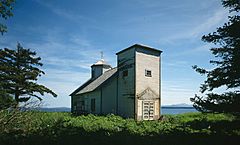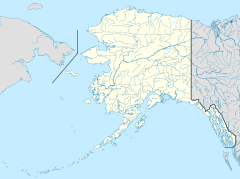Afognak, Alaska facts for kids
Quick facts for kids
Afognak
Agw'aneq
|
|
|---|---|
|
Village
|
|

Nativity of Holy Theotokos Church
|
|
 |
|
| Country | United States of America |
| State | Alaska |
| Borough | Kodiak Island Borough |
| Island | Afognak Island |
| First settled | abt. 5,500 B.C.E. |
| Destroyed | March 27, 1964 (Good Friday earthquake) |
| Named for | Named by Russian settlers; derived from Afognak Island in 1839. |
| Time zone | UTC-9 (AKST) |
| • Summer (DST) | UTC-8 (AKDT) |
Afognak (/əˈfɒɡnæk/), also known as Agw'aneq in the Alutiiq tongue, was a village of the Alutiiq people. It was located on Afognak Island in Kodiak Island Borough, Alaska, United States. The village was on Afognak Bay, which is on the southwest coast of the island. This spot was about three miles north of Kodiak Island. Today, the area where Afognak once stood is part of the community of Aleneva.
Contents
History of Afognak Village
Afognak has a long and interesting history, stretching back thousands of years. It tells the story of the Alutiiq people and how their lives changed over time.
Early Life in Afognak
For over 7,500 years, the Alutiiq people lived in many settlements across the Kodiak Archipelago. The people of Afognak were skilled at fishing and hunting sea mammals. They used special boats called kayaks, which were covered in seal skin. Men and women in the village had different jobs to help their community thrive. They also traded goods and services with other groups in Southeast Alaska and the Aleutian chain.
Russian Influence in Afognak
In 1784, the Russian American Company arrived on Afognak Island. The Russians asked some men from the village to hunt sea otters. These furs were then sold in Europe. However, many Alutiiq people faced very difficult conditions during this time. Also, a serious illness called the smallpox epidemic spread between 1837 and 1840. This epidemic sadly caused many deaths in the area.
Because of these changes, the Alutiiq people began to adapt their way of life. The name "Afognak" comes from Afognak Island. It was first written down in 1839 by a Russian officer named Mikhail Murashev. Both the native people and the Russians on the island continued to fish, hunt, and gather food. Even with some disagreements, many Russians and Alutiiq people married and started families. Many Alutiiq also learned Russian and became part of the Russian Orthodox faith. However, they did not forget their own Alutiiq traditions; they simply added new customs to them.
Over time, Russian workers who married into the native community often settled in special retirement areas. One such area, called Russian Town, grew next to Aleut Town. Eventually, these two communities joined together to form the village of Afognak.
The American Period in Afognak
The United States bought the rights to Alaska in 1867. After this, schools were set up that only taught in English. This was challenging because many people did not speak English. But by 1900, many young people in Afognak could speak three languages: Alutiiq, Russian, and English!
In the late 1800s, the U.S. fishing industry grew a lot. Many canneries (places where fish are processed and canned) opened in Kodiak, Alaska. Fishermen from places like Scandinavia also came to Alaska. This increase in fishing activity caused some tension with the Alutiiq people, who wanted to keep their traditional fishing lifestyle. Afognak had a post office that opened and closed at different times from 1888 until 1964.
A big natural disaster happened in 1912 when Mount Katmai erupted. The village of Afognak was covered by about one meter (3 feet) of ash from the volcano. Then, on March 27, 1964, a huge event called the Good Friday earthquake struck. This earthquake caused a giant wave, a tsunami, which completely destroyed the village of Afognak.
With help from the Lions Club and the government, a new community was built. This new village was located on the northeast coast of Kodiak Island. It was named Port Lions to honor the Lions Club for their help. The people who used to live in Afognak moved to Port Lions permanently in December 1964. Even so, a small number of people (11 residents) were still living in the old Afognak area as late as 1980.
Population Changes
The population of Afognak changed a lot over the years. Here's how it looked during different U.S. Census counts:
| Historical population | |||
|---|---|---|---|
| Census | Pop. | %± | |
| 1880 | 339 | — | |
| 1890 | 409 | 20.6% | |
| 1900 | 307 | −24.9% | |
| 1910 | 318 | 3.6% | |
| 1920 | 308 | −3.1% | |
| 1930 | 298 | −3.2% | |
| 1940 | 197 | −33.9% | |
| 1950 | 148 | −24.9% | |
| 1960 | 190 | 28.4% | |
| 1980 | 11 | — | |
| U.S. Decennial Census | |||
Afognak first appeared in the U.S. Census in 1880. At that time, it was an unincorporated village with 339 residents. Most of them were "Creole" (people of mixed Russian and native heritage). The census continued to count the population until 1960. After the 1964 Good Friday earthquake, most people left. The village did not appear in the 1970 census. However, it was listed again in 1980 as an Alaskan Native Village, with only 11 residents. Since then, it has not been counted separately. As of 2000, the original area of Afognak is mostly within the community of Aleneva.
Geography of Afognak
Afognak village was located on the southwestern shore of Afognak Island. This island is part of the Kodiak Island Borough in Alaska, United States. The village was situated about three miles north of Kodiak Island.


